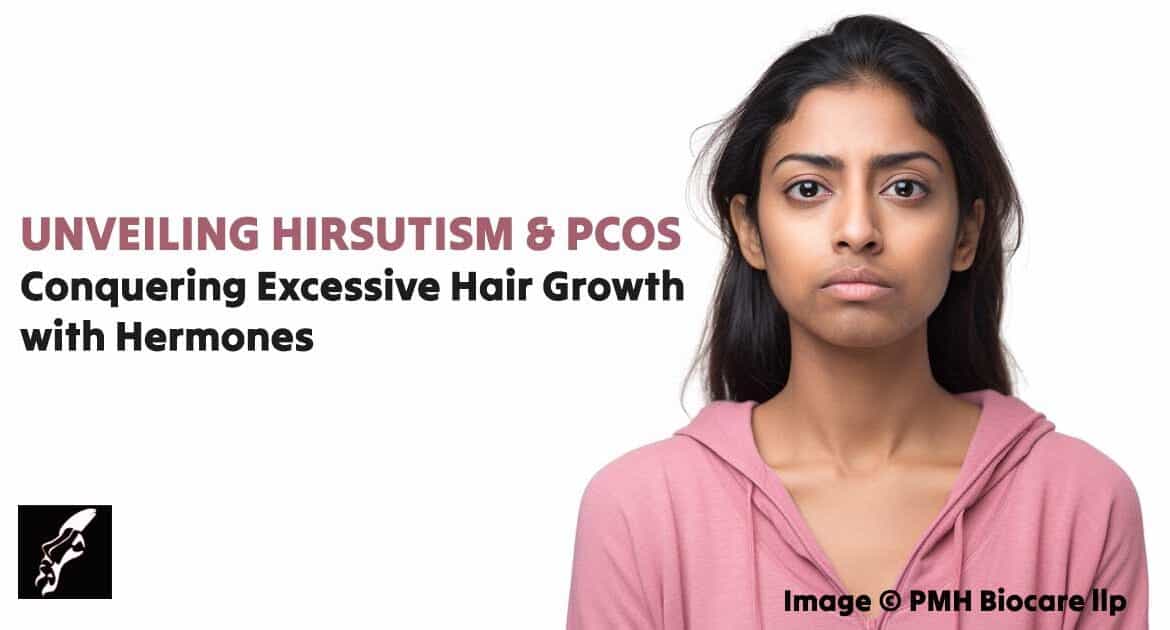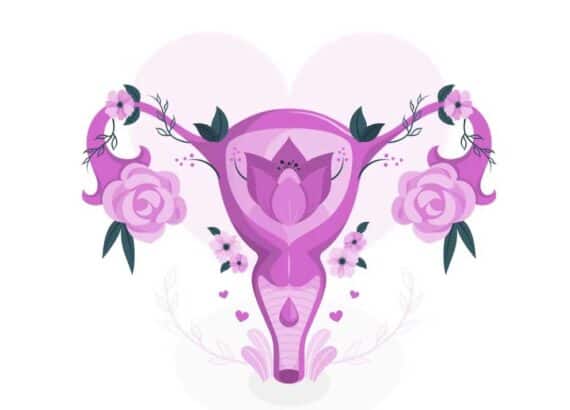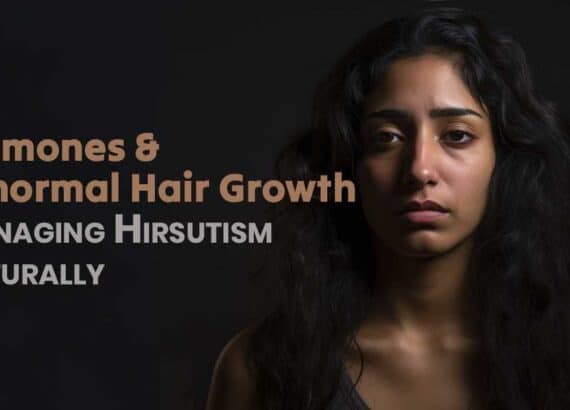Hirsutism and PCOS: Conquering Excessive Hair Growth with Hermones

Bold, confident, and beautiful—that’s how every woman deserves to feel. However, when faced with the relentless challenge of hirsutism, the journey to self-acceptance can become arduous. Fear not, for within this article lies the key to understanding and combating excessive hair growth. Delve into the depths of hirsutism and its close ties to polycystic ovary syndrome (PCOS), as we unravel the secrets of a flawless complexion and lasting confidence.
Overview of Normal Hair Growth:
Before we embark on the quest to conquer hirsutism, let us first understand the intricate workings of normal hair growth. Hair, like nature itself, follows a cyclical pattern. It grows, rests, and sheds—transforming our appearance with every cycle. It is this delicate dance between growth and renewal that defines the natural harmony of our hair.
- Hair growth follows a cycle consisting of three main phases: anagen (active growth), catagen (transition), and telogen (resting).
- The duration of each phase can vary based on genetics, age, and overall health.
- Hormonal fluctuations, particularly androgens like testosterone and DHT, influence the growth cycle.
- Hair follicles, located beneath the skin, produce and elongate the hair shaft during the anagen phase.
- Sensitivity of hair follicles to hormonal changes can affect the growth process.
- The shedding process is a natural part of the hair cycle, allowing for renewal and regrowth.
- Disruptions in the shedding process can lead to the accumulation of unwanted hair.
Effects of Androgens on Hair Growth:
Enter the fascinating realm of androgens, the hormones responsible for shaping our hair’s destiny. Androgens, such as testosterone, play a pivotal role in hair growth regulation. Their influence can either promote luscious locks or lead to an overabundance of unwanted hair. Understanding the effects of androgens is the key to unlocking the mystery behind hirsutism.
- Androgens, such as testosterone and DHT, are crucial in regulating hair growth. They bind to androgen receptors in hair follicles, initiating hair growth. Androgens stimulate the growth phase (anagen) of the hair cycle.
- Androgen receptors in hair follicles respond differently in individuals. Sensitivity to androgens can vary, leading to variations in hair growth patterns.
- Hormonal imbalances, like in hirsutism and PCOS, can disrupt androgen levels. Excess androgens can overstimulate hair follicles, causing excessive hair growth.
- The conversion of testosterone to DHT by 5-alpha-reductase affects hair follicles. DHT, a potent androgen, binds strongly to androgen receptors, impacting hair growth.
Understanding the effects of androgens on hair growth helps us comprehend the mechanisms behind conditions like hirsutism. By addressing hormonal imbalances and regulating androgen levels, targeted treatments can manage excessive hair growth and promote healthier hair growth patterns.
Causes of Hirsutism:
The origins of hirsutism can be as diverse as the human tapestry itself. Multiple factors contribute to this condition, each bearing its own unique imprint. Let’s explore the various causes that can set the stage for hirsutism’s unwelcome appearance:
- Excessive production of androgens by the ovaries (polycystic ovary syndrome, tumor)
- Excessive sensitivity of hair follicles to androgens (genetic)
- Excessive production of androgens by the adrenal glands (non-classical adrenal hyperplasia [NCAH])
- Insulin resistance
- Hyperandrogenism, insulin resistance, acanthosis nigricans (HAIR-AN syndrome)
- Excessive production of cortisol by the adrenal glands (Cushing syndrome)
- Menopause
- Medication
Diagnosing Hirsutism:
To conquer any adversary, we must first identify it. Diagnosing hirsutism requires a keen eye and a comprehensive understanding of its intricacies. Medical professionals employ various diagnostic tools to unravel the mystery of excessive hair growth. From thorough medical histories to hormonal assessments, the path to diagnosis leads us one step closer to victory.
- A comprehensive medical history and physical examination are important for diagnosis.
- Blood tests measure hormone levels, including androgens and insulin.
- Imaging tests like ultrasounds and MRIs evaluate the ovaries and adrenal glands.
- Other conditions causing excessive hair growth need to be ruled out.
- Specialists like endocrinologists and dermatologists help with diagnosing hirsutism.
Potential Consequences of Hirsutism:
Hirsutism’s impact extends far beyond the superficial realm. Beyond the visible hair, lies a plethora of potential consequences that can affect both physical and emotional well-being. Explore the depths of these consequences as we shed light on the profound effects of hirsutism:
- Hirsutism can affect self-esteem, body image, and mental well-being.
- It can be challenging socially and impact relationships, dating, and marriage.
- Hirsutism is linked to anxiety, depression, and other mental health conditions.
- Career choices and personal aspirations can be affected.
Treatment of Hirsutism:
Armed with knowledge, we march forward to the battleground of hirsutism, equipped with an arsenal of treatments aimed at restoring balance and reclaiming confidence. The path to victory presents itself in the form of both medical interventions and cosmetic treatments. Let us delve into these realms of transformation and explore the weapons at our disposal:
Medications
- Birth control pills: Harnessing the hormonal symphony to restore equilibrium and reduce excessive hair growth.
- Androgen receptor blockers: Intercepting the incessant whispers of androgens, hindering their impact on hair follicles.
- Spironolactone: Unleashing the power of anti-androgens, countering the effects of androgens and promoting a smoother canvas.
- Flutamide: Disrupting the androgen cascade for triumphant results, obstructing the pathway that fuels unwanted hair growth.
- Glucocorticosteroids: Taming the storm of cortisol production, curbing its influence on hair follicles and promoting balance.
- Dexamethasone: A formidable weapon against hirsutism, silencing the clamor of excessive hair growth.
- Prednisone: Standing strong against the forces of unruly hair, inhibiting the factors that perpetuate hirsutism.
- Methylprednisolone: Unveiling a tranquil realm free from excessive hair growth, calming the overactive adrenal glands.
- Enzyme inhibitors: Unraveling the mystery of excessive androgen production, disrupting the enzymes responsible for their synthesis.
- Finasteride: Nurturing the roots of victory, blocking the conversion of testosterone into its more potent form.
- GnRH analogs: Regulating hormonal harmony for lasting relief, normalizing the hormonal fluctuations that fuel hirsutism’s flames.
Cosmetic Treatments
- Shaving: A swift and temporary solution for unruly hair, providing immediate smoothness and respite.
- Eflornithine cream: A gentle touch in the fight against hirsutism, inhibiting hair growth at the follicular level.
- Waxing: The art of uprooting unwanted hair, delivering longer-lasting results and smoother skin.
- Bleaching: Camouflaging the relentless intruders, lightening the appearance of excess hair for a subtler presence.
- Plucking: Precision and patience in the pursuit of smoothness, targeting individual hair strands for meticulous removal.
- Depilatory agents: Dissolving the barriers of excess hair, offering a convenient and temporary solution to hirsutism.
- Electrolysis: A permanent farewell to hirsutism’s stronghold, employing electrical currents to eradicate hair follicles.
- Laser: Harnessing the power of light for radiant liberation, targeting hair follicles to inhibit growth and achieve long-lasting results.
The Power of Early Intervention:
In the realm of hirsutism and PCOS, timing holds the key to triumph. The battle against excessive hair growth is best fought when detected at a young age. By monitoring yourself and your loved ones for early signs of hirsutism, you pave the way for swifter diagnosis and effective treatment. Empower yourself with knowledge and vigilance, and secure a brighter future free from the shackles of unwanted hair.
- Early detection helps prevent long-term consequences of hirsutism.
- Monitoring hair growth during adolescence and seeking medical help early on is crucial.
- Education and awareness campaigns empower individuals to recognize hirsutism symptoms.
- Support systems like counseling and peer groups are available.
- Early intervention improves treatment outcomes and quality of life.
Understanding the Emotional Impact:
Dealing with hirsutism can be emotionally challenging for many women. Society often places a strong emphasis on female beauty standards, which can further exacerbate feelings of self-consciousness and isolation. It is important to recognize that hirsutism is a medical condition and not a reflection of personal hygiene or lifestyle choices. Seeking support from friends, family, or support groups can provide encouragement and a safe space to discuss concerns and experiences. Emotional well-being is an essential aspect of overall health, and addressing the psychological impact of hirsutism is as important as managing the physical symptoms.
Managing Hirsutism with Hermones: A Natural Solution for Excessive Hair Growth
Hirsutism is a condition characterized by excessive and unwanted hair growth in women, typically in areas where men usually have hair, such as the face, chest, abdomen, back, and buttocks. It can be a distressing and challenging condition, affecting a woman’s self-esteem and confidence. While there can be various underlying causes of hirsutism, hormonal imbalances, particularly an increase in androgen levels, are often a contributing factor.
Hermones, a natural supplement specifically designed to correct hormonal imbalances in women, can play a significant role in managing hirsutism. By addressing the root cause of the condition, Hermones aims to restore hormonal balance and alleviate the symptoms associated with excessive hair growth.
Conclusion:
In conclusion, managing hirsutism goes beyond addressing the physical symptoms—it involves acknowledging the emotional impact and seeking support, as well as exploring natural supplements such as Hermones to restore hormonal balance. With the right combination of support, understanding, and effective management strategies, women can embrace their unique beauty and confidently navigate the journey towards overcoming hirsutism. Remember, you are not alone, and there is hope for a brighter, hair-free future.





